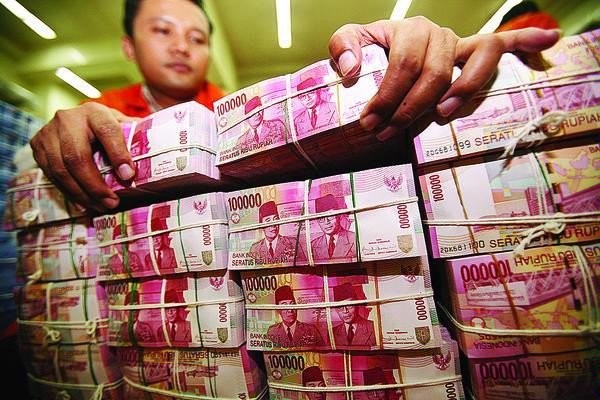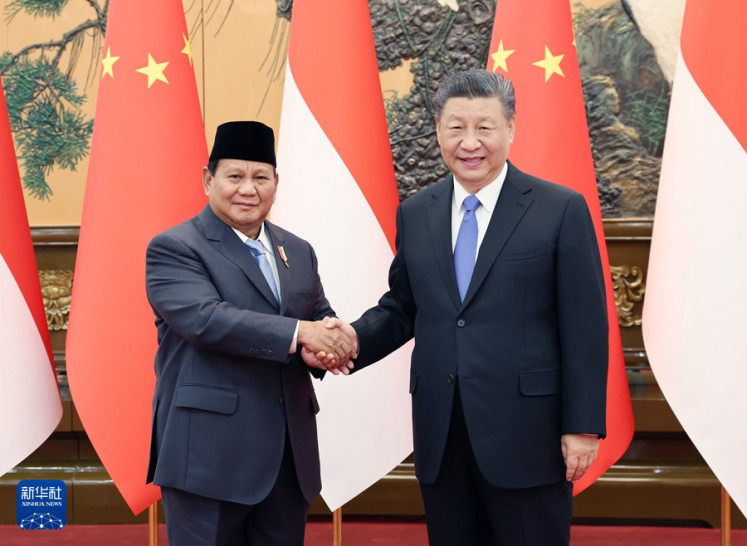Interest rate: How low can it go?
From the theoretical perspective, low interest rates are an important prerequisite for investment demand. In Bank Indonesia’s (BI) point of view, high interest rates cause many adverse effects. On one hand, a high deposit interest rate could eliminate entrepreneurial spirit.
Change text size
Gift Premium Articles
to Anyone
 An officer arranges a stack of cash at a Bank Indonesia cash center in Jakarta. (Kompas /Lasti Kurnia)
An officer arranges a stack of cash at a Bank Indonesia cash center in Jakarta. (Kompas /Lasti Kurnia)
S
ince it was first introduced in April 2016, the benchmark interest rate, the seven-day reverse repo rate, has been cut three times. The current rate is 4.75 percent, down 75 basis points so far.
This low interest rate regime is in line with the trend in many countries. European countries and the United States, for example, have been aggressively implementing very low (even negative) interest rates to stabilize macroeconomic conditions since the 2008 global financial crisis.
From the theoretical perspective, low interest rates are an important prerequisite for investment demand. It also is a necessary condition for stimulating bank credit. Ultimately, investment and bank credit are intended to promote economic growth, labor absorption and income distribution equalization.
In Bank Indonesia’s (BI) point of view, high interest rates cause many adverse effects. On one hand, a high deposit interest rate could eliminate entrepreneurial spirit. People would save their money in the bank rather than run businesses. A high cost of funds undoubtedly drives product prices so they are less competitive on the global market.
On the other hand, if interest rates remain high, investments could not be advanced. Both direct and portfolio investment would stagnate. The stock and bond markets would no longer be attractive. As a result, financial markets would be very fragile, while foreign portfolio funds control 65 percent of financial markets and are always on the lookout for higher interest rates or returns.
As stated by the BI governor, the easy monetary policy would be continued into next year.
First, the exchange rate and inflation rate are manageable. The yearon-year inflation rate as of October was 3.08 percent.
Meanwhile, the cumulative first ten-month inflation rate was 2.11 percent. Hence, the overall inflation rate in the current year is expected to be 3.2 percent.
Second, the current account deficit was surprisingly below 2 percent of GDP. Also, the size of the balance of payments surplus has been increasing as exports began to pick up and imports weakened. As a result, the foreign reserves as of September booked a new highest record of US$115.7 million.
The above macroeconomic performances have convinced BI to relax its monetary policy in terms of cutting the repo rate at least once again either this month or next month. However, some obstacles have recently emerged.
In the international context, the global financial market could be volatile since Donald Trump has been elected as the new president of the US. The unclear economic policy directions proposed by Trump could cause turbulence for the next few next months.
At the same time, the Fed will increase its rate. As Indonesia is a small open economy, BI would obviously take into account the possibility of an increase in the Fed rate in December. In integrated financial markets, the prevailing interest rates in one country will approximate the interest rates in other countries, both in magnitude and change in direction.
The experience at the end of the last year provided a very valuable lesson. After the Fed rate was raised by 25 basis points in December 2015, BI lowered the BI rate to 7.25 percent. But the rupiah slumped and foreign exchange reserves shrank sharply, induced by massive capital outflow.
In the domestic context, benchmark interest rate cuts are claimed to have been ineffective so far in repressing bank interest rates. While borrowing interest rates have decreased by 100 basis points, in contrast, lending interest rates have declined more slowly, by 52 basis points throughout this year.
The Financial Services Authority (OJK) noted that the average rate of bank lending was 12.31 percent, which was quite high compared to the average saving or deposit interest rate of 6.94 percent as of August. Therefore, the single digit banking interest rate target will not be achieved by the end of this year.
Benchmark interest rate cuts that have not yet been proportionally followed by a decrease in borrowing interest rates imply a liquidity crunch. The liquidity crunch could even become a liquidity trap, making monetary policy ineffective.
In such a case, financial market participants would no longer be responsive to changes in the repo rate. This means that there is a certain minimum limit at which a decline in the repo rate can be tolerated. At that limit, financial market players choose to avoid financial assets because of the prevailing belief that the repo rate will soon rise.
What repo rate will trigger a liquidity trap? The exact rate is not definitively known. BI can only speculate. Thus, the trend of benchmark interest rate cuts so far is likely to be a trial by BI to identify the lowest repo rate acceptable to the financial markets.
However, as far as low interest rates in the Indonesian financial market are under consideration, they cannot be zero percent or even negative, as in Europe or Japan. They have their own characteristics. Moreover, the macroeconomic environment surrounding the monetary policy is absolutely different.
As an illustration, at present the repo rate is almost the same as the level of a five-year credit default swap at 1.5 percent plus the outlook rate of inflation, amounting to 3.2 percent. The liquidity trap has seemingly already been reached. If BI continues to impose the easy-biased money policy, investors will liquidate all their financial assets.
Financial asset liquidation implies further a sharply increased demand for dollars. When the supply of dollars is thin, foreign exchange reserves erode to meet the high demand for dollars. Eventually, the rupiah falls.
In short, the main challenges faced by the repo rate are not far from capital outflow, foreign exchange reserves and the exchange rate. Consequently, a trade-off inevitably happens. Pursuing internal stability (inflation rate, banking interest rates and financial market liquidity) will override external stability; and vice versa.
***
The writer is research director at Socio-Economic & Educational Business Institute (SEEBI) Jakarta and lecturer at the School of Economics, State University of Jakarta. He earned his PhD in economics from Gadjah Mada University, Yogyakarta.
---------------
We are looking for information, opinions, and in-depth analysis from experts or scholars in a variety of fields. We choose articles based on facts or opinions about general news, as well as quality analysis and commentary about Indonesia or international events. Send your piece to community@jakpost.com. For more information click here.









